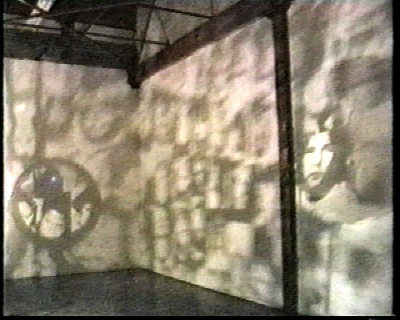
We enter a room in which floats suspended from the ceiling a curious mechanical device:
Fiona Bowie's shadowgraph projector. The glowing humming object casts blurry inverted images of faces over every
surface of the room. Lenses orbit the object like planets in a mechanical solar system, creating moving trajectories
of round focused images in the sea of blurred countenances.
The shadowgraph projector that Bowie has designed and fabricated differs from traditional projection equipment in a
number of obvious but significant ways. A conventional slide projector shows individual images in sequence, and is focused
and masked to form straight edges. These machines are usually hidden out of sight in a dark corner or a projection booth,
which sets up a clear position for the viewer: there is only one correct direction to look in and only one thing at a time
to look at. One can trace a history of this viewer position back to classical perspective with its implied privileged
objective viewpoint. When confronted with Bowie's omni-directional, randomly focused, doubly "unmasked" projector, the
privileged viewpoint we are used to inhabiting in relation to projected images is destabilized. Instead of being hidden
away in a projector booth Bowie's equipment takes center stage, reminding us that both the image and its method of
presentation are productive of meaning.
While viewing Bowie's shadowgraph our bodies are illuminated by the projector and our own and others' shadows interrupt
the cast images. The voyeuristic pleasure offered by cinema to see without being seen is impossible here. Instead, our
viewing pleasure comes in part from aesthetic experiences that have been banished from the movie theatre: the beauty of
blurred images the magic and fragility of the disembodied photograph, and the play of shadows cast by people moving in
front of the images. The projector itself is a seductive source of visual pleasure - translucent, glowing, and available
for our inspection.
The images that Bowie has paired with this device are closely related to the device that projects them. Like the
shadowgraph itself, the collaged images allow for no stable viewing position. Row after row of photographs of people
are cropped in an arbitrary fashion that would seem to indicate that much of the original content of these photographs
has been eliminated. Bowie thus omits the ways in which the photographic portrait ordinarily works to re inscribe social
position and status through the coded details of gesture, surroundings and possessions. The result is a sea of faces.
This diverse group becomes the "crowd": many-faced and faceless simultaneously. Photography's cataloguing and
ranking functions are cheekily referenced through Bowie's grouping of photos by general facial expressionÖ an arbitrary
categorization that works to frustrate established hierarchies.
Our familiarity with the codes and conventions of photographic imagery allows us to speculate that some of these images
were previously mug shots, snap shots, or studio portraits. However, any concentration on the individual faces is discouraged
by the presentation: the images are upside down and transparent on the projector and either blurry or fleetingly focused on
the wall. These dematerialized, de-contextualized portraits lack the connotations of permanence and stability that even a
color snapshot provides to stave off anxiety about our own mortality. The very materiality of photographs ordinarily suggests
that because our likeness is preserved our existence is confirmed and we will not be forgotten. Bowie's work reveals the
portrait as fragile, temporal, and vulnerable-inadequate in the face of our certain collective and individual mortality.
Carol Sawyer October 1996
Copyright 1998 grunt Gallery Publication,www.gruntgallery.bc.ca ‘
swell ‘. Sawyer, Carol. Exhibition essay, ISBN -1-895329-27-2 .